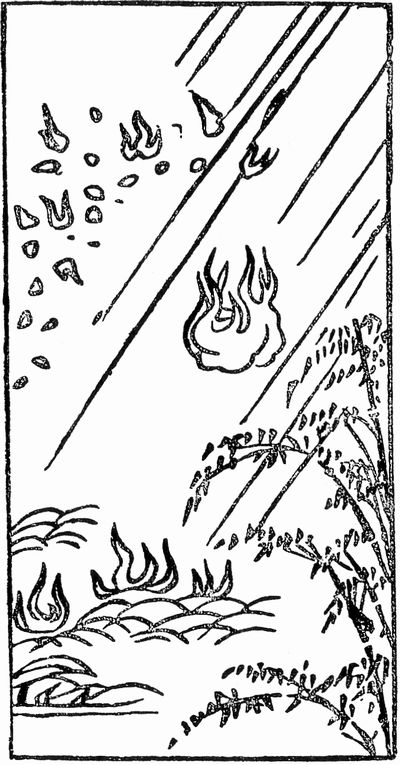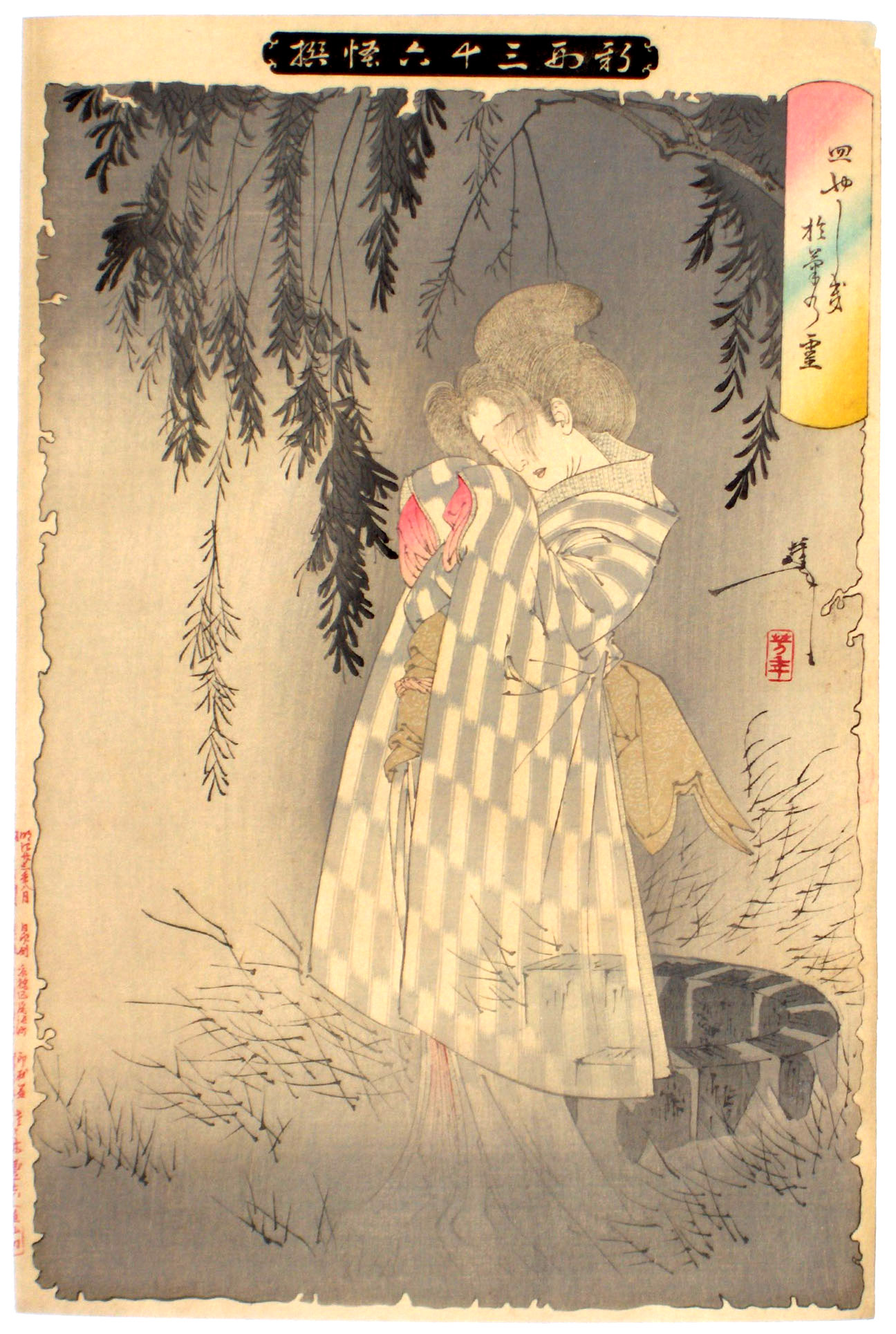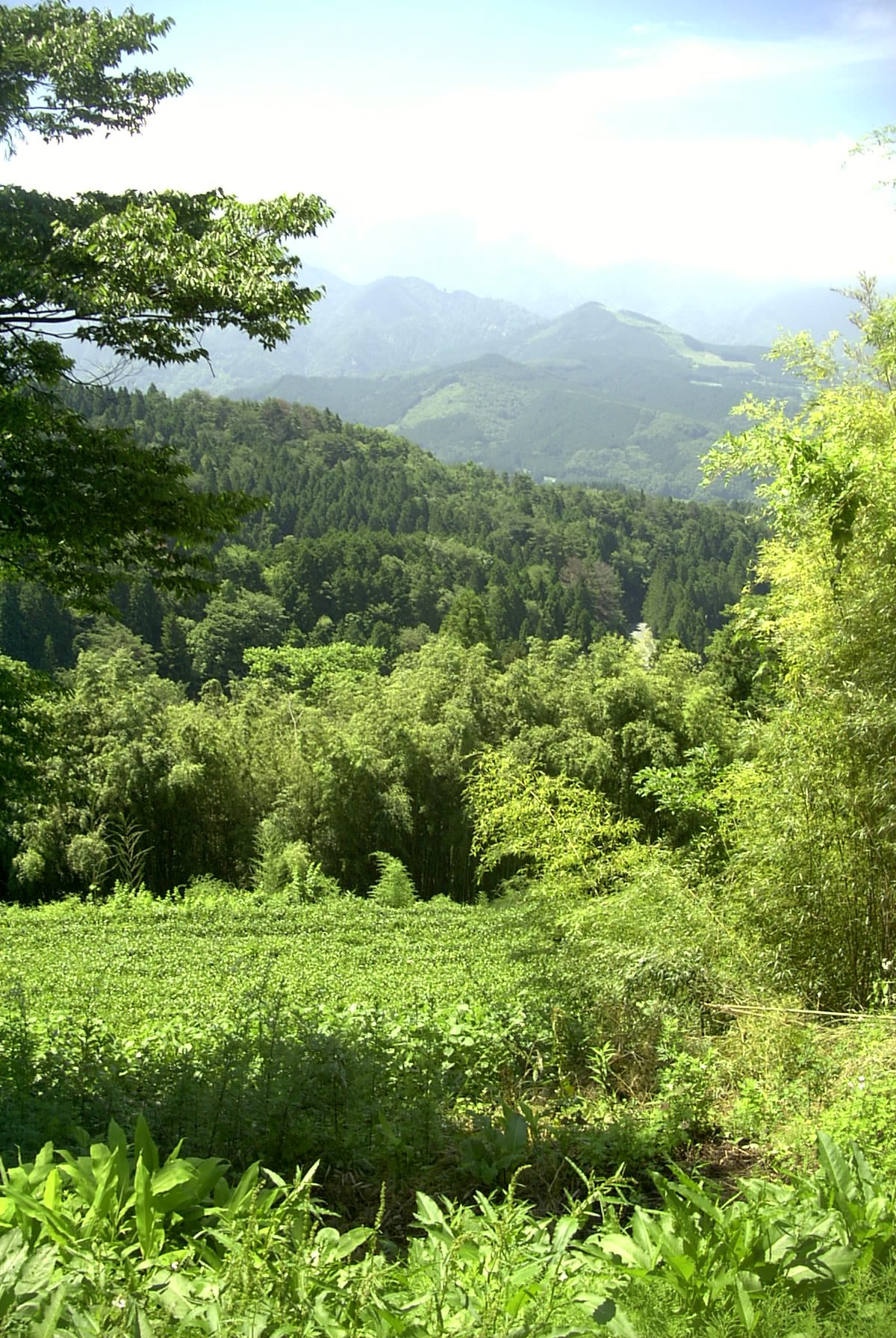|
Onibi
is a type of atmospheric ghost light in legends of Japan. According to folklore, they are the spirits born from the corpses of humans and animals. They are also said to be resentful people that have become fire and appeared. Also, sometimes the words "will-o'-wisp" or "jack-o'-lantern" are translated into Japanese as "onibi". Outline According to the Wakan Sansai Zue written in the Edo period, it was a blue light like a pine torchlight, and several onibi would gather together, and humans who come close would have their spirit sucked out. Also, from the illustration in the same Zue, it has been guessed to have a size from about two or three centimeters in diameter to about 20 or 30 centimeters, and to float in the air about one or two meters from the ground. According to Yasumori Negishi, in the essay " Mimibukuro" from the Edo period, in chapter 10 "Onibi no Koto", there was an anecdote about an onibi that appeared above Hakone mountain that split into two and flew around, gath ... [...More Info...] [...Related Items...] OR: [Wikipedia] [Google] [Baidu] |
Kitsunebi
Kitsunebi (狐火) is an atmospheric ghost light told about in legends all across Japan outside Okinawa Prefecture.村上健司編著 『妖怪事典』 毎日新聞社、2000年、134頁。。 They are also called "hitobosu", "hitomoshi" (火点し), and "rinka" (燐火). Overview Kimimori Sarashina, a researcher of local stories, summarizes the features of the kitsunebi as follows: in places where there'd be no presence of fire, mysterious flames like those of paper lantern or a torch would appear in a line and flicker in and out, with fires that have gone out sometimes even appearing in yet another place, so that if one attempted to chase after what was behind all this, it would disappear in the middle. When they appear between spring and autumn, they show up especially in hot summers and appear easily when it is cloudy when the weather is changing. They are said to appear from between ten and several hundred in a line, and just when one thinks that they have increased, they wo ... [...More Info...] [...Related Items...] OR: [Wikipedia] [Google] [Baidu] |
Atmospheric Ghost Lights
Atmospheric ghost lights are lights (or fires) that appear in the atmosphere without an obvious cause. Examples include the onibi, hitodama and will-o'-wisp. They are often seen in humid climates. Tsunoda 1979, pages 11-53 According to legend, some lights are wandering spirits of the dead, the work of devils (or yōkai), or the pranks of fairies. They are feared by some people as a portent of death. In other parts of the world, there are folk beliefs that supernatural fires appear where treasure is buried; these fires are said to be the spirits of the treasure or the spirits of humans buried with grave goods. Atmospheric ghost lights are also sometimes thought to be related to UFOs.Kanda 1992, pages 275-278. Some ghost lights such as St. Elmo's fire or the shiranui have been explained as optical phenomena of light emitted through electrical activity. Other types may be due to combustion of flammable gases, ball lightning, meteors, torches and other human-made fires, the mispercep ... [...More Info...] [...Related Items...] OR: [Wikipedia] [Google] [Baidu] |
Janjanbi
Janjanbi (じゃんじゃん火 or ジャンジャン火) is an atmospheric ghost light told about the legends of various places in the Nara Prefecture. They are considered a type of onibi. In the Miyazaki Prefecture they are also called musabi (むさ火) and in the Kōchi Prefecture, they are also called kechibi. Outline Their name comes from the "janjan" sound that they make. Also in Nara, there are different legends depending on the area, and different alternate names depending on the area. ;Byakugō-ji town, Nara city :It indicates two balls of fire that appear in the graveyard of Byakugō-ji and Daian-ji. In the Fūfu River, the two balls of fire would meet together, intertwine themselves, and then finally return to their graves. :When a person sees this fire, it would come closer to that person, and even when those who are chased by the janjanbi flee into the middle of a pond, the fire would still follow them above the pond. :They are said in the legends to be a man and a ... [...More Info...] [...Related Items...] OR: [Wikipedia] [Google] [Baidu] |
Will-o'-wisp
In folklore, a will-o'-the-wisp, will-o'-wisp or ''ignis fatuus'' (, plural ''ignes fatui''), is an atmospheric ghost light seen by travellers at night, especially over bogs, swamps or marshes. The phenomenon is known in English folk belief, English folklore and much of European folklore by a variety of names, including jack-o'-lantern, friar's lantern, hinkypunk and is said to mislead travellers by resembling a flickering lamp or lantern. In literature, will-o'-the-wisp metaphorically refers to a hope or goal that leads one on, but is impossible to reach, or something one finds strange or sinister. Wills-o'-the-wisp appear in folk tales and traditional legends of numerous countries and cultures; notable wills-o'-the-wisp include St. Louis Light in Saskatchewan, the Spooklight in Southwestern Missouri and Northeastern Oklahoma, the Marfa lights of Texas, the Naga fireballs on the Mekong in Thailand, the Paulding Light in Upper Peninsula of Michigan and the Hessdalen light ... [...More Info...] [...Related Items...] OR: [Wikipedia] [Google] [Baidu] |
Gazu Hyakki Yagyō
is the first book of Japanese artist Toriyama Sekien's famous ''Gazu Hyakki Yagyō'' e-hon tetralogy, published in 1776. A version of the tetralogy translated and annotated in English was published in 2016. Although the title translates to "The Illustrated Night Parade of a Hundred Demons", it is based on an idiom, ''hyakki yagyō,'' that is akin to pandemonium in English and implies an uncountable horde. The book is followed by '' Konjaku Gazu Zoku Hyakki'', ''Konjaku Hyakki Shūi'', and '' Gazu Hyakki Tsurezure Bukuro''. The book is a supernatural bestiary, a collection of ghosts, spirits, spooks and monsters from literature, folklore, and other artwork. The art of ''Gazu Hyakki Yagyō'' heavily references a 1737 scroll-painting called the ''Hyakkai Zukan'' by artist Sawaki Sūshi; Sekien's innovation was preparing the illustrations as woodblock prints that could be mass-produced in a bound book format. Intended as a parody of then-popular reference books such as the ''Wakan S ... [...More Info...] [...Related Items...] OR: [Wikipedia] [Google] [Baidu] |
Kyoto
Kyoto (; Japanese: , ''Kyōto'' ), officially , is the capital city of Kyoto Prefecture in Japan. Located in the Kansai region on the island of Honshu, Kyoto forms a part of the Keihanshin metropolitan area along with Osaka and Kobe. , the city had a population of 1.46 million. The city is the cultural anchor of a substantially larger metropolitan area known as Greater Kyoto, a metropolitan statistical area (MSA) home to a census-estimated 3.8 million people. Kyoto is one of the oldest municipalities in Japan, having been chosen in 794 as the new seat of Japan's imperial court by Emperor Kanmu. The original city, named Heian-kyō, was arranged in accordance with traditional Chinese feng shui following the model of the ancient Chinese capital of Chang'an/ Luoyang. The emperors of Japan ruled from Kyoto in the following eleven centuries until 1869. It was the scene of several key events of the Muromachi period, Sengoku period, and the Boshin War, such as the Ōnin War, ... [...More Info...] [...Related Items...] OR: [Wikipedia] [Google] [Baidu] |
Banchō Sarayashiki
is a Japanese ghost story (kaidan) of broken trust and broken promises, leading to a dismal fate. Alternatively referred to as the tradition, all versions of the tale revolve around a servant, who dies unjustly and returns to haunt the living. Some versions take place in or , others in the area in Edo. History The story of the death of Okiku () first appeared as a bunraku play called ''Banchō Sarayashiki'' in July 1741 at the Toyotakeza theater. The familiar ghost legend had been adapted into a '' ningyō jōruri'' production by Asada Iccho and Tamenaga Tarobei I. Like many successful bunraku shows, a kabuki version followed and in September 1824, ''Banchō Sarayashiki'' was staged at the Naka no Shibai theater starring Otani Tomoemon II and Arashi Koroku IV in the roles of Aoyama Daihachi and Okiku. A one-act kabuki version was created in 1850 by Segawa Joko III, under the title ''Minoriyoshi Kogane no Kikuzuki,'' which debuted at the Nakamura-za theater and starred ... [...More Info...] [...Related Items...] OR: [Wikipedia] [Google] [Baidu] |
Sekien Toriyama
200px, A Miage-nyūdō.html" ;"title="Mikoshi-nyūdō, specifically a Miage-nyūdō">Mikoshi-nyūdō, specifically a Miage-nyūdō, as portrayed by Toriyama , real name Sano Toyofusa, was an 18th-century scholar, ''kyōka'' poet, and ''ukiyo-e'' artist of Japanese folklore. Born to a family of high-ranking servants to the Tokugawa shogunate, he was trained by Kanō school artists Kanō Gyokuen and Kanō Chikanobu, although he was never officially recognized as a Kanō school painter. Art career After retiring from service to the shogunate, he became a teacher to numerous apprentices in poetry and painting. He was among the first to apply Kanō techniques to ''ukiyo-e'' printmaking, inventing key new techniques along the way, such as ''fuki-bokashi'', which allowed for replicating color gradations. Most famously, he was the teacher of Kitagawa Utamaro and Utagawa Toyoharu. Sekien is best known for his mass-produced illustrated books of yōkai that had appeared in ''Hyakki Yagyō'' ... [...More Info...] [...Related Items...] OR: [Wikipedia] [Google] [Baidu] |
Konjaku Gazu Zoku Hyakki
is the second book of Japanese artist Toriyama Sekien's famous ''Gazu Hyakki Yagyō'' tetralogy, published c. 1779. A version of the tetralogy translated and annotated in English was published in 2016. These books are supernatural bestiaries, collections of ghosts, spirits, spooks, and monsters, many of which Toriyama based on literature, folklore, other artwork. These works have had a profound influence on subsequent ''yōkai'' imagery in Japan. ''Konjaku Gazu Zoku Hyakki'' is preceded in the series by ''Gazu Hyakki Yagyō'', and succeeded by ''Konjaku Hyakki Shūi'' and ''Gazu Hyakki Tsurezure Bukuro''. List of creatures The three volumes were titled 雨, 晦, and 明. From this book, Toriyama added captions. First Volume – 雨 (Rain) Image:SekienOmagatoki.jpg, Image:SekienOni.jpg, Image:SekienSansei.jpg, Image:SekienHiderigami.jpg, Image:SekienSuiko.jpg, Image:SekienSatori.jpg, Image:SekienShuten-doji.jpg, Image:SekienHashihime.jpg, Image:SekienHannya.jpg, Im ... [...More Info...] [...Related Items...] OR: [Wikipedia] [Google] [Baidu] |
Kōchi Prefecture
is a prefecture of Japan located on the island of Shikoku. Kōchi Prefecture has a population of 757,914 (1 December 2011) and has a geographic area of 7,103 km2 (2,742 sq mi). Kōchi Prefecture borders Ehime Prefecture to the northwest and Tokushima Prefecture to the northeast. Kōchi is the capital and largest city of Kōchi Prefecture, with other major cities including Nankoku, Shimanto, and Kōnan. Kōchi Prefecture is located on Japan's Pacific coast surrounding a large bay in the south of Shikoku, with the southernmost point of the island located at Cape Ashizuri in Tosashimizu. Kōchi Prefecture is home to Kōchi Castle, considered the most intact Japanese castle, and the Shimanto River, one of the few undammed rivers in Japan. History Kōchi Prefecture was historically known as Tosa Province and was controlled by the Chōsokabe clan in the Sengoku period and the Yamauchi clan during the Edo period. Kōchi city is also the birthplace of noted revolution ... [...More Info...] [...Related Items...] OR: [Wikipedia] [Google] [Baidu] |
Gifu Prefecture
is a Prefectures of Japan, prefecture of Japan located in the Chūbu region of Honshu. Gifu Prefecture has a population of 1,991,390 () and has a geographic area of . Gifu Prefecture borders Toyama Prefecture to the north; Ishikawa Prefecture to the northwest, Fukui Prefecture and Shiga Prefecture to the west, Mie Prefecture to the southwest, Aichi Prefecture to the south, and Nagano Prefecture to the east. Gifu is the capital and largest city of Gifu Prefecture, with other major cities including Ōgaki, Kakamigahara, and Tajimi. Gifu Prefecture is located in the center of Japan, one of only eight landlocked prefectures, and features the country's center of population. Gifu Prefecture has served as the historic Intersection (road), crossroads of Japan with routes connecting the east to the west, including the Nakasendō, one of the Edo Five Routes, Five Routes of the Edo period. Gifu Prefecture was a long-term residence of Oda Nobunaga and Saitō Dōsan, two influential figure ... [...More Info...] [...Related Items...] OR: [Wikipedia] [Google] [Baidu] |
Ibi District, Gifu
is a district located in Gifu Prefecture, Japan. , the district has an estimated population of 72,109. The total area is 876.65 km2. The area of the former village of Tokuyama in this district will be flooded by the Tokuyama Dam. Towns and villages *Ibigawa * Ikeda * Ōno District Timeline * April 1, 1987 - The village of Tokuyama merged into the village of Fujihashi. * January 31, 2005 - The villages of Fujihashi, Kasuga, Kuze, Sakauchi, and Tanigumi merged into the expanded town of Ibigawa is a town located in Ibi District, Gifu Prefecture, Japan. , the town had an estimated population of 21,319 in 8,015 households and a population density of 27 persons per km2, in 8,032 households. The total area of the town was . Geography I .... Notes Districts in Gifu Prefecture {{Gifu-geo-stub ... [...More Info...] [...Related Items...] OR: [Wikipedia] [Google] [Baidu] |







